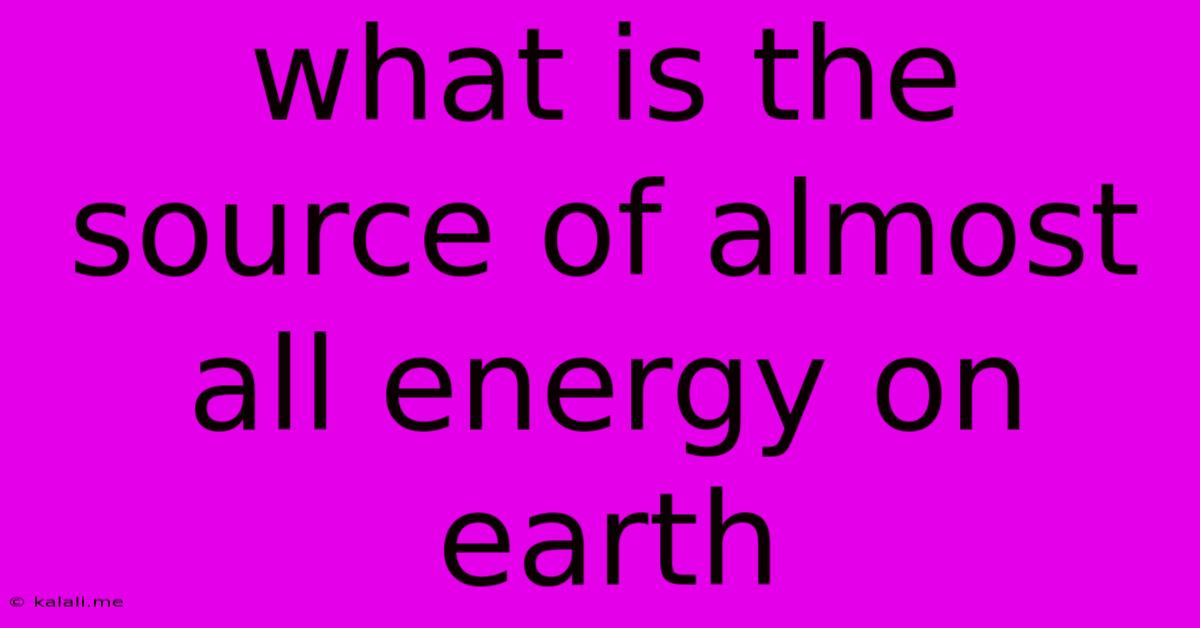What Is The Source Of Almost All Energy On Earth
Kalali
Jun 13, 2025 · 3 min read

Table of Contents
What is the Source of Almost All Energy on Earth?
The sun. That's the simple answer, but let's delve deeper into why our celestial neighbor is the ultimate powerhouse driving nearly all life and energy processes on Earth. This article will explore the various ways solar energy fuels our planet, from the obvious to the more subtle. Understanding this fundamental source is key to comprehending our planet's intricate systems and the challenges we face in transitioning to sustainable energy solutions.
The Sun: Our Primary Energy Source
The sun's energy, generated through nuclear fusion in its core, is the foundation of almost all energy systems on Earth. This energy reaches our planet primarily through solar radiation, which encompasses visible light, ultraviolet radiation, and infrared radiation. While we directly harness solar energy through photovoltaic cells and solar thermal systems, its influence extends far beyond these technologies.
Indirect Manifestations of Solar Energy
The sun's energy doesn't just warm us; it drives a complex chain of events that power most of Earth's processes. Consider these examples:
-
Photosynthesis: Plants and algae use sunlight to convert carbon dioxide and water into glucose (sugar), storing solar energy in chemical bonds. This process forms the base of most food chains, providing energy for all other living organisms, including humans. This is arguably the most important indirect manifestation of solar energy. Without photosynthesis, life as we know it wouldn't exist.
-
Wind Energy: Solar radiation heats the Earth unevenly, creating temperature differences that drive atmospheric circulation. This circulation results in wind, which we can harness using wind turbines. Wind energy is, therefore, an indirect form of solar energy.
-
Hydropower: The sun's energy evaporates water, forming clouds and precipitation. This water cycle replenishes rivers and lakes, powering hydroelectric dams that generate electricity. Even the subtle energy of ocean currents is driven by the sun's heat.
-
Fossil Fuels: While seemingly a separate energy source, fossil fuels (coal, oil, and natural gas) are essentially stored solar energy. Millions of years ago, sunlight fueled the growth of ancient plants and microorganisms. Their remains, buried and compressed over eons, transformed into the fossil fuels we utilize today. Burning these fuels releases the stored solar energy, although this is a finite and environmentally damaging process.
-
Biomass Energy: Similar to fossil fuels, biomass energy (wood, crops, agricultural waste) originates from plants that utilize solar energy during photosynthesis. Burning biomass releases this stored solar energy, although its sustainability depends heavily on responsible forestry and agricultural practices.
Geothermal Energy: A Partial Exception
Geothermal energy, sourced from the Earth's internal heat, represents a relatively minor exception. While not directly derived from the sun, this internal heat is a leftover from the planet's formation and the radioactive decay of elements within the Earth's core. Although a significant energy source in specific locations, its overall contribution to Earth's energy balance is considerably smaller than solar energy.
Conclusion: The Sun's Unparalleled Influence
In conclusion, while geothermal energy contributes, the sun is overwhelmingly the dominant source of almost all energy on Earth. Its influence extends from directly powering solar panels to indirectly driving wind, hydropower, the growth of plants, and the formation of fossil fuels. Understanding this fundamental principle is crucial for developing sustainable energy strategies and fostering a more environmentally responsible future. The challenge lies in harnessing this abundant solar energy more efficiently and sustainably, reducing our reliance on finite and polluting fossil fuels.
Latest Posts
Latest Posts
-
How Fast Does A Peacock Run
Jun 14, 2025
-
Which Of These Lines Is A Metaphor
Jun 14, 2025
-
Difference Between Quality Control And Quality Assurance Pdf
Jun 14, 2025
-
Gpa Requirements For University Of Memphis
Jun 14, 2025
-
What Are The Prime Factors Of 156
Jun 14, 2025
Related Post
Thank you for visiting our website which covers about What Is The Source Of Almost All Energy On Earth . We hope the information provided has been useful to you. Feel free to contact us if you have any questions or need further assistance. See you next time and don't miss to bookmark.